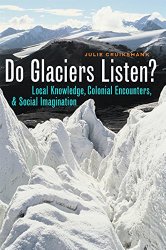$37.95
$33.31
(SAVE Now!)
as of 12/22/2024 (Details)
The glaciers creepLike snakes that watch their prey, from their far fountains,Slow rolling on.– Percy Shelley, “Mont Blanc,” 1816Glaciers in America’s far northwest figure prominently in indigenous oral traditions, early travelers’ journals, and the work of geophysical scientists. By following such stories across three centuries, this book explores local knowledge, colonial encounters, and environmental change.Do Glaciers Listen? examines conflicting depictions of glaciers to show how natural and social histories are entangled. During late stages of the Little Ice Age, significant geophysical changes coincided with dramatic social upheaval in the Saint Elias Mountains. European visitors brought conceptions of Nature as sublime, as spiritual, or as a resource for human progress. They saw glaciers as inanimate, subject to empirical investigation and measurement. Aboriginal responses were strikingly different. From their perspectives, glaciers were sentient, animate, and quick to respond to human behaviour. In each case, experiences and ideas surrounding glaciers were incorporated into interpretations of social relations.Focusing on these contrasting views, Julie Cruikshank demonstrates how local knowledge is produced, rather than “discovered,” through such encounters, and how oral histories conjoin social and biophysical processes. She traces how divergent views continue to weave through contemporary debates about protected areas, parks and the new World Heritage site that encompasses the area where Alaska, British Columbia, and the Yukon Territory now meet. Students and scholars of Native studies and anthropology as well as readers interested in northern studies and colonial encounters will find Do Glaciers Listen? a fascinating read and a rich addition to circumpolar literature.Winner of the Victor Turner Prize for Ethnographic Writing, 2006
Technical Details
- Used Book in Good Condition
